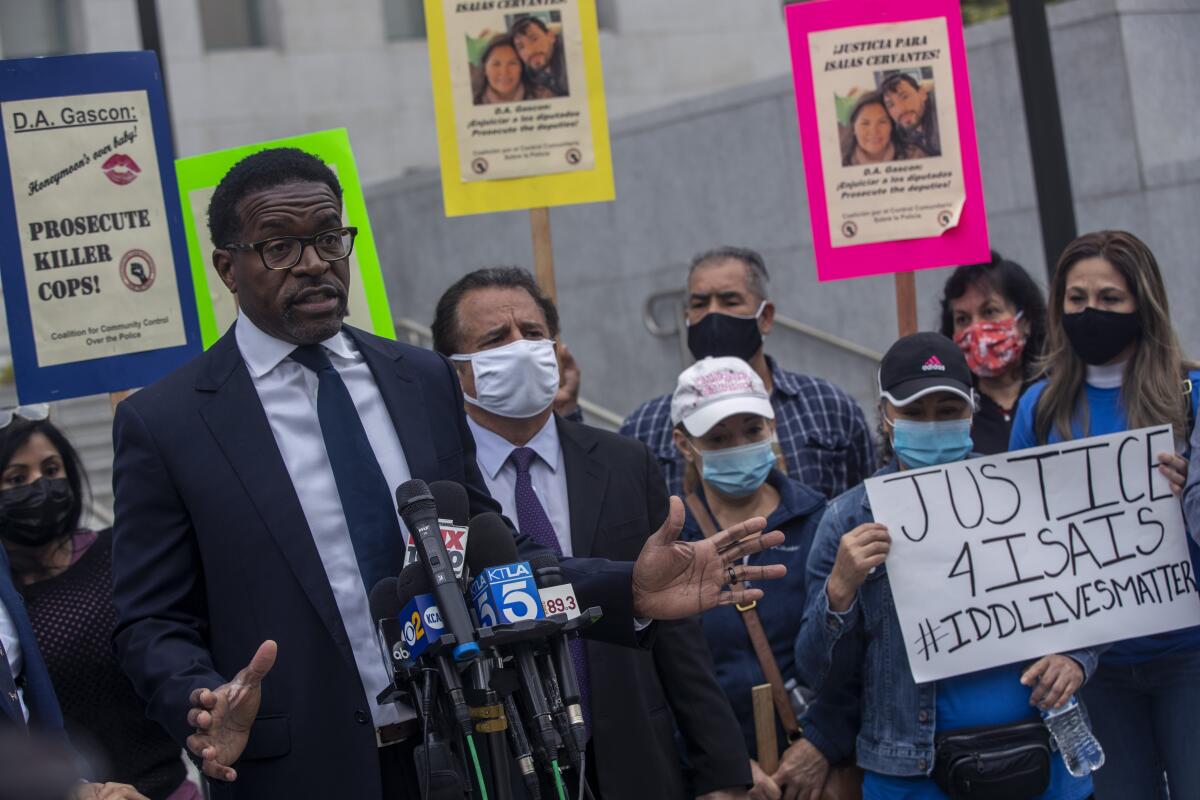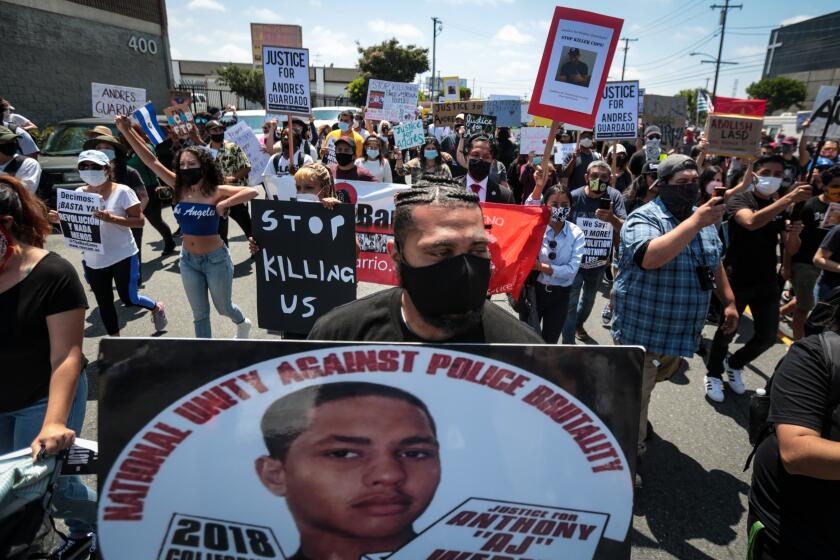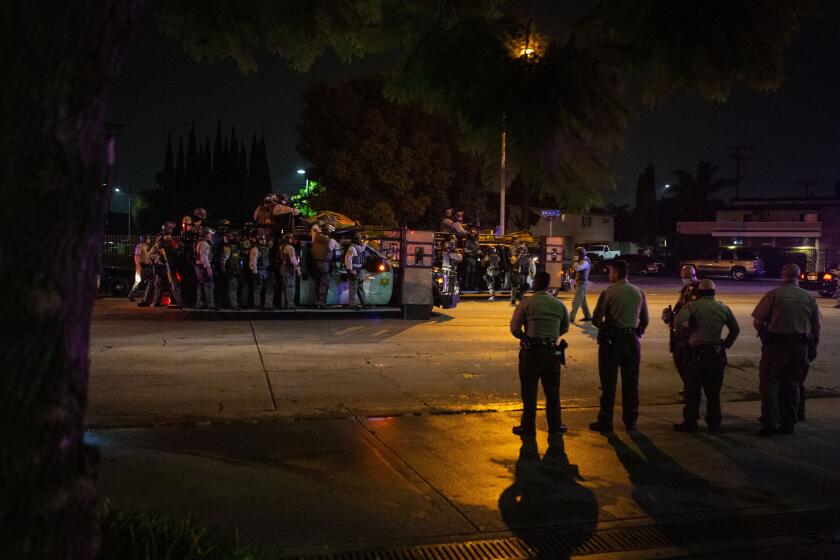Editorial: Sheriff’s shooting costs taxpayers $25 million. Where’s the accountability?

- Share via
Los Angeles County sheriff’s officials concluded that two deputies acted within department policy when they confronted and one of them shot Isaias Cervantes, a mentally disabled man in his home in 2021. A corrective action plan (at least, the portion that is public) identified nothing in sheriff’s policies or procedures that needs to be changed to prevent a similar shooting.
So it seems incongruous that county lawyers are suggesting that the Board of Supervisors on Tuesday sign off on an astounding $25 million to settle a lawsuit brought on behalf of Cervantes, who was paralyzed as a result of the March 31, 2021, shooting.
Sheriff misconduct often results in huge payouts to injured parties, but it’s the public that pays, leaving law enforcement agencies little incentive to improve. They will become accountable only when they start picking up the tab for the damage they cause.
That’s a huge payout, even for Los Angeles County, which spent $257 million on legal settlements and judgments last year. More than half of that amount was attributable to lawsuits against the Sheriff’s Department. Liabilities that run that high signal serious problems in county policies and employee conduct. They should be accompanied by meaningful improvements.
But the summary corrective action plan notes no department-wide or systemic changes, and no response beyond reminding personnel of department protocols.
Isaias Cervantes, a deaf and autistic man shot and paralyzed by sheriff’s deputies in his own home last year, has been traumatized by public agencies that are supposed to help him.
Department use-of-force investigators and county officials cited problems at several stages of the response, including the failure of desk personnel to ask about the nature of Cervantes’ mental impairment and the failure to send a Mental Evaluation Team as part of the response.
Once deputies arrived on the scene, though, they were deemed to have done nothing officially wrong. Similar conclusions have been reached in many other cases, in L.A. and around the country, in which families called for assistance with a mentally disabled or disturbed relative, beginning a series of entirely foreseeable events that concluded with law enforcement officers killing or seriously injuring the person they were there ostensibly to help.
The sheriff and other law enforcement leaders should be judged in part by how much deputies’ misconduct costs taxpayers.
The Cervantes case was unusual in that the shooting victim survived. To add insult to serious injury, the Sheriff’s Department asked the district attorney to charge Cervantes with assault and resisting arrest — although there was no arrest. Prosecutors declined. Nor did they charge the deputies.
The Board of Supervisors generally signs off on lawsuit settlements, even huge ones like the Cervantes case, without comment to the public. That may satisfy the Sheriff’s Department and county lawyers, but it leaves taxpayers holding the bag without assurance that the county will try to prevent a recurrence. And it exposes a continuing gulf between citizens who call for service and law enforcement personnel who respond.
The women were ordered to line up outdoors, strip, and toss their clothes onto the concrete in front of them.
For example, Cervantes’ family, like many overwhelmed by the responsibility of caring for a mentally disabled relative, called for help, not for force. But sheriff’s deputies, according to documents presented to the Board of Supervisors, believed they were responding to an assault.
Deputies told Cervantes he was not in any trouble and then attempted to handcuff him in order to safely question him, in accordance with standard law enforcement practices. Yet most people would object to being handcuffed, especially while sitting in their own home, if they are not under arrest. And it should not be unreasonable to expect that a person under stress in such a situation might resist, as Cervantes did, resulting in his being shot.
L.A. County will pay $700,000 to a public radio journalist who was slammed to the ground and arrested by deputies while covering a 2020 protest.
The settlement will come from money paid to the department by cities that contract for its services. One of those cities is Cudahy, where Cervantes was shot.
Before signing off on the $25 million, the supervisors should ask whether the new 988 crisis line that was not yet available at the time of the Cervantes shooting is preventing recurrences of such tragedies. If not, they should ask whether it’s because of insufficient public awareness or insufficient availability of alternative county responses. They should ask about the sufficiency of the corrective action plan, and whether the Sheriff’s Department continues to send deputies to similar situations without a Mental Evaluation Team. They should ask about handcuffing protocols.
And they should ask whether they can be reasonably certain that nothing like this will happen again. And, if it does, whether county taxpayers might be upset about having to pay the bill again.
More to Read
A cure for the common opinion
Get thought-provoking perspectives with our weekly newsletter.
You may occasionally receive promotional content from the Los Angeles Times.















